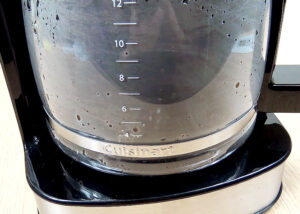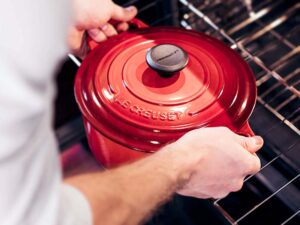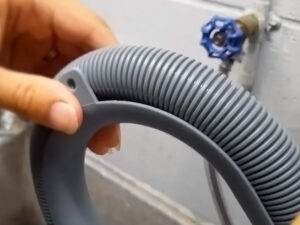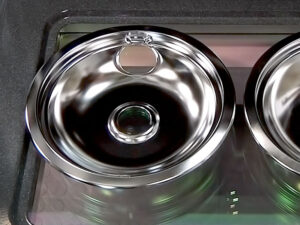The Frigidaire countertop ice maker is a great choice for your kitchen. It adds convenience and allows you to always have ice available whenever you need it. But, just like any other appliance, you need to do regular maintenance to make sure it works well and makes ice that’s clean and safe to eat. It’s important to clean your Frigidaire countertop ice maker regularly. This helps prevent dirt, bacteria, and mineral deposits from building up, which can affect the quality of the ice and how well the machine works. In this guide, we will walk you through each step of the cleaning process, giving you detailed instructions to help you maintain your ice maker in great condition.
How to Clean Your Frigidaire Countertop Ice Maker
It’s really important to clean your Frigidaire countertop ice maker regularly so that the ice it produces is clean and safe to use. Sure, I can provide you with a simple step-by-step guide on how to clean your ice maker:
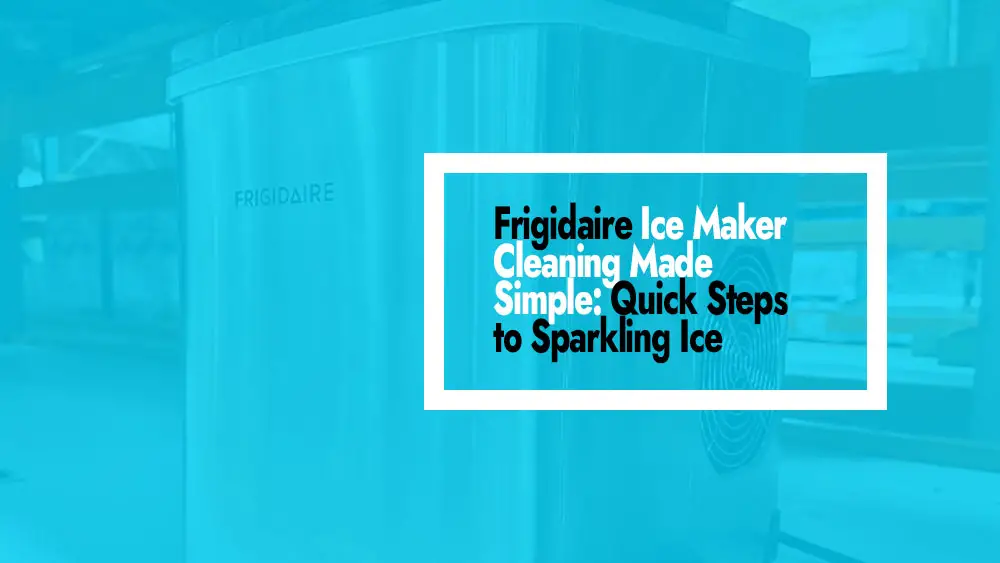
Make sure you have all the things you need
Make sure you have all the supplies you need before you start cleaning. To clean, you’ll need some basic supplies like a soft cloth or sponge, mild dish soap, warm water, a small brush (like an old toothbrush), white vinegar, and a clean, dry towel. Make sure you unplug the ice maker and empty the ice bin completely before you begin cleaning.
Unplug the ice maker and empty it
Let’s start by making safety our top priority. To prevent any accidents while cleaning, make sure to disconnect the ice maker from the power source. Also, make sure to empty the ice bin completely. Remove any leftover ice to start with a clean surface for the cleaning process.
Remove the parts and accessories
The parts that can be removed may differ depending on the specific model of your Frigidaire ice maker. You can check the user manual to find out which parts can be removed for a more thorough cleaning. Some of the parts that can be easily removed are the ice tray, water reservoir, and ice scoop. Please, take your time and handle these parts with care as you remove them. Set them aside so that you can clean them later.
Cleaning removable parts
Now that you’ve taken off the detachable parts, it’s time to concentrate on cleaning each one separately. You can make a cleaning solution by mixing warm water and mild dish soap together. You can dip a soft cloth or sponge into the solution and then gently scrub the ice tray, water reservoir, and ice scoop. Make sure to give extra attention to any dirt, residue, or mineral deposits that are being stubborn. After you clean each part, make sure to rinse them thoroughly with clean water to get rid of any leftover soap residue.
Clean the interior
To clean the inside of the ice maker, you can make a simple cleaning solution by combining equal amounts of water and white vinegar. This solution will help get rid of mineral buildup and prevent any bacteria from growing. Take a soft cloth or sponge and dip it into the solution. Make sure to wring it out well so that it’s not too wet. Start by wiping down the inside surfaces, which include the ice-making mechanism, the water inlet, and the space around the ice tray. If you have any tight or hard-to-reach spots, you can use a small brush like an old toothbrush to carefully clean away any dirt or buildup.
Descale the ice maker
Sometimes, minerals in water can build up and form what we call mineral deposits or scales. This happens gradually over time. When there are deposits, it can make the ice maker less efficient and affect the quality of the ice it makes. To address this issue, you can make a descaling solution by combining an equal amount of water and white vinegar.
Please pour this solution into the water reservoir and start a cycle. This will allow the ice maker to make a batch of ice. Just a heads up, this batch of ice might still have some of the descaling solutions in it, so it’s best to throw it away. After you finish the descaling cycle, make sure to run another cycle using clean water. This will help ensure that any leftover vinegar is completely flushed out.
Exterior cleaning
When you start cleaning the outside of the ice maker, it’s important to take a comprehensive approach. To clean the outer surfaces, you can use a soft cloth that’s slightly damp with warm, soapy water. Just gently wipe them down. Make sure you give extra attention to buttons, control panels, and any areas that are likely to gather fingerprints, spills, or dirt. To avoid water spots, make sure to dry the outside completely with a clean, dry towel.
Reassemble and restart it
Now that all the components are clean and dry, it’s time to put the ice maker back together. Please put the ice tray, water reservoir, and ice scoop back where they belong, making sure they are placed securely. Just plug the ice maker back into the power source and let it run through a couple of cycles before using the ice. This step is important because it helps make sure that any leftover cleaning solution or debris is completely removed. This way, you won’t have any strange taste or smell in your ice.
Different Ways to Clean Your Frigidaire Countertop Ice Maker: Alternative Methods You Can Try Out
When it comes to keeping your Frigidaire countertop ice maker clean, you might find that traditional cleaning methods don’t always meet your preferences or needs. Fortunately, there are other ways you can clean and keep your ice maker in good condition. In this guide, we will go through different ways to clean your Frigidaire countertop ice maker. We will provide you with easy-to-follow instructions for each method.
Using lemon juice
Lemon juice is a great natural cleaner because it has acid that can break down mineral deposits and get rid of odors. To get started, just combine the same amount of lemon juice and water in a bowl. You can dip a soft cloth or sponge into the mixture and then gently wipe down the inside and outside of the ice maker. Make sure to keep an eye out for any areas that have mineral buildup or stains. Lemon juice is great for cleaning and it also leaves a nice, refreshing scent. Make sure to rinse the ice maker with clean water in order to get rid of any leftover lemon juice.
Baking soda paste
Baking soda is a really handy cleaning agent that’s known for being gentle on surfaces while still having some scrubbing power. To make a paste, all you need to do is mix some baking soda with a little bit of water. You can take a soft cloth or sponge and apply the paste to it. Then, use it to gently scrub the inside of the ice maker, including the ice tray and water reservoir. You can use a baking soda paste to easily get rid of tough stains and residues. Make sure to rinse the ice maker really well with water so that there’s no baking soda left behind.
Commercial ice maker cleaner
If you like using specific cleaning products, you might want to think about buying a cleaner specifically made for commercial ice makers. Make sure to read and follow the instructions provided by the manufacturer regarding how to dilute the product and apply it correctly. Usually, these cleaners are made to dissolve mineral deposits and clean the ice maker. Once you’ve applied the cleaner and followed the instructions, make sure to rinse the ice maker thoroughly with clean water. This will ensure that there are no traces of the cleaner left behind.
Steam cleaning
If you want to try something more advanced, you could consider using a handheld steam cleaner to clean your ice maker. Steam’s high temperature is effective in dissolving dirt, mineral deposits, and bacteria. Make sure to unplug the ice maker and make sure it is completely dry before using a handheld steam cleaner. Carefully guide the steam towards the inside parts and small spaces, making sure not to get any electronic components too wet. Use a cloth to remove any loose dirt and debris. Make sure to let the ice maker dry completely before plugging it back in.
Ice maker cleaning tablets
Ice maker cleaning tablets are made to specifically target mineral deposits and mold buildup. You usually dissolve these tablets in water and then use them to clean the ice maker. Just make sure to read and follow the instructions on the packaging for the right way to use and dilute it. The tablets work by going through a cycle that effectively cleans the inside parts and water lines. Afterwards, make sure to run a cycle with clean water to flush out any leftover residue.
Cleaning your Frigidaire countertop ice maker is important for keeping it in good shape and making sure it works well and stays clean. If you carefully follow the instructions in this guide and use the right cleaning supplies, you’ll always have fresh and clean ice for your drinks and get-togethers.
Some Simple Tips to Maintain Your Frigidaire Countertop Ice Maker and Prevent Any Issues from Arising
If you want your Frigidaire countertop ice maker to last longer and work well all the time, it’s important to take some proactive steps to care for it. In addition to regular cleaning, there are a few preventive tips you can follow to keep your appliance working well and ensure you have great ice for a long time.
Regular cleaning schedule
When it comes to cleaning your ice maker, it’s important to be consistent. Sure, let’s create a cleaning schedule that works well for your specific usage patterns. Cleaning regularly is important because it helps prevent the buildup of mineral deposits, mold, and bacteria. These things can affect the quality of your ice and make your machine less efficient.
Focus on ensuring the quality of water
The water you use has a direct impact on the quality of the ice it produces. If the mineral content in your tap water is high, you might want to think about using filtered or purified water instead. If you use filtered water, you’ll notice that your ice maker doesn’t get mineral buildup as often. This means you’ll have cleaner ice and a healthier appliance.
Remember to empty the ice bin from time to time
If you leave the ice in the bin for a long time, it can clump together and get freezer burn. To keep the ice in good condition, it’s a good idea to regularly empty the ice bin. To keep your extra ice fresh and free from any contaminants, it’s a good idea to store it in sealed containers or freezer bags. This will help maintain its quality for longer periods of time.
Proper ventilation
It’s really important to make sure your ice maker has proper ventilation so it doesn’t overheat. Make sure you put the ice maker in a spot where there’s enough air circulation. Make sure you don’t put it in small spaces or close to anything hot that might stop it from cooling properly.
Make sure not to overload the ice bin
It can be tempting to fill the ice bin completely, but doing that can strain the ice maker and make it less efficient. Make sure there’s enough room in the bin for the ice to move around easily. This will help avoid putting too much pressure on the inside parts.
Clean the outside regularly
It’s important to remember that keeping the outside of your ice maker clean is just as crucial as cleaning the inside. Make sure to regularly clean the outside surfaces by using a damp cloth. This will help get rid of any dust, fingerprints, or other dirt that may have accumulated. Not only does this help keep the appliance looking nice, but it also stops dirt from getting inside.
Check the water lines and connections
Make sure to regularly inspect the water lines and connections for any indications of leaks, cracks, or harm. Please make sure to address any issues promptly to avoid water damage to your appliance and the surrounding area. Make sure to replace any damaged components as soon as possible to prevent any further issues from occurring.
Properly Store and Transport Items
Make sure you clean and dry your ice maker completely before storing or moving it. You should keep it in a cool and dry place, ideally in the original packaging. Make sure you don’t keep it in places where the temperature changes a lot or where there’s too much moisture.
Consult the User Manual
The manufacturer’s user manual has important details about how to take care of your ice maker. It includes specific maintenance suggestions for your particular model. Take some time to get to know these guidelines so that you can make sure you’re following the best practices for your appliance.
Professional maintenance
You might want to think about scheduling some professional maintenance for your ice maker, especially if you’ve been having ongoing issues or if you’ve noticed that it’s not working as well as it used to. Trained technicians have the skills to find the root causes of issues, give your ice maker a deep clean, and fix any problems that may be affecting its performance. This will help bring your ice maker back to its best condition.
Be careful when handling controls
Please handle the controls, buttons, and control panel with care. If you press buttons or adjust settings too forcefully, it can cause damage to the interface over time. Please handle these components with care to help them last longer.
If you make these preventive tips a part of your routine, it can really help your Frigidaire countertop ice maker last longer, work better, and perform at its best. To keep your ice maker in great shape and producing top-notch ice, it’s important to follow a few simple steps. First, make sure to clean it regularly and manage the water properly. Also, be mindful of how you use it. And every now and then, consider getting professional maintenance done. By doing these things, you’ll keep your ice maker running smoothly and producing high-quality ice.
Frequently Asked Questions
It’s really important to regularly maintain your Frigidaire countertop ice maker so that it lasts a long time and works its best. You should aim to clean every two to three months, but it’s a good idea to adjust the frequency depending on how often you use it for even better results. If you notice that the ice doesn’t seem as good as usual, tastes different, or has a bad smell, it could mean that you need to clean it more often.
You can definitely use tap water, but it’s worth thinking about the minerals in your water source. If the tap water you use has a lot of minerals, it can cause a buildup of minerals over time. This can make your ice maker less efficient and affect the quality of the ice it makes. It’s a good idea to choose filtered or purified water. This can help prevent minerals from building up and make sure your ice tastes cleaner and better.
To prevent ice clumping, you need to consider a few different factors. Make sure to regularly empty the ice bin so that the ice doesn’t sit for too long. Also, if you store extra ice in sealed containers, it can stop moisture from making the ice stick together. You can try lowering the temperature settings of the ice maker a bit to help keep it colder. This can help prevent the ice from sticking together.
Vinegar and lemon juice work really well as natural cleaning agents, but if you prefer, you can also try using commercial ice maker cleaners that are recommended by the manufacturer. These cleaners are made to dissolve mineral deposits and get rid of mold and bacteria. Make sure you read and follow the instructions on how to use it properly. Also, remember to rinse it thoroughly to make sure there’s no leftover cleaning residue.
Yes, using a handheld steam cleaner can be effective when cleaning your ice maker. Just be careful and make sure the appliance is fully unplugged and dry before you continue. Please remember to be careful when directing steam to prevent electronic components from getting wet. Once you’re done steam cleaning, just grab a cloth and wipe away any loose debris. Make sure to let the ice maker dry completely before plugging it back in.
Yes, it’s definitely important to unplug the ice maker before cleaning it. It’s a safety precaution that you shouldn’t forget. This precaution is in place to make sure that you don’t accidentally turn on the appliance while you’re cleaning the inside parts. It’s meant to keep you safe and prevent any potential harm.
It’s not a good idea to store your ice maker in the freezer. Ice makers are typically made to be used on countertops, so they might not be able to handle the extremely cold temperatures inside a regular freezer. If you do that, it might harm the appliance and affect how well it works.
It’s totally normal for an ice maker to make different sounds while it’s cleaning and even afterwards. This happens because of the way water moves around and ice forms inside the machine. But if the noises keep happening, get louder, or seem strange, just check your user manual or contact customer support for help.
It’s important to regularly check your water lines and connections to prevent any leaks. Make sure that all the connections are secure and not damaged. Make sure not to put too much water in the reservoir, because if there’s too much, it might spill or leak. Make sure to quickly deal with any problems that arise to avoid any water damage to the appliance and the area around it.
There are a couple of reasons why your ice cubes might be smaller than usual. One possibility is that the water flow is not as strong as it should be. Another reason could be that there is a clog in the water line. To fix this issue, you should inspect the water inlet and lines for any blockages. If you find any, make sure to clean them thoroughly. Also, make sure that there is enough water available to keep the ice maker working at its full capacity.
Lingering smells can happen when there are leftover bits of food or if mold starts to grow. Please make sure to clean all parts thoroughly, including the water reservoir and ice tray. You can also try putting a product that neutralizes odors inside the ice bin to help get rid of any unwanted smells.
There are a couple of reasons why ice production might decrease. One possibility is that the water pressure is low, which can affect how much ice is made. Another reason could be that the temperature settings are not correct, which can also impact ice production. Please check if there is enough water in the supply, make sure the ice maker is set to the temperature you want, and you might want to clean the appliance to get rid of any mineral buildup.
After you clean your ice maker, you can speed up the drying process by using a hairdryer on a low, cool setting. But be careful not to use too much heat, as it could potentially harm the delicate parts. Just remember, it’s usually best to let the ice maker air dry completely before reconnecting it. This will ensure that it dries thoroughly.
Final Thoughts
Cleaning your Frigidaire countertop ice maker is important for keeping it in good shape and working well. It also helps to make sure your appliance stays clean and hygienic. If you carefully follow the instructions in this guide and use the right cleaning supplies, you’ll always have plenty of clean ice for your drinks and get-togethers. I recommend checking your user manual for instructions on how to clean your Frigidaire ice maker and how often it should be cleaned. This will help you keep your ice maker in good condition and enjoy it for a long time.


